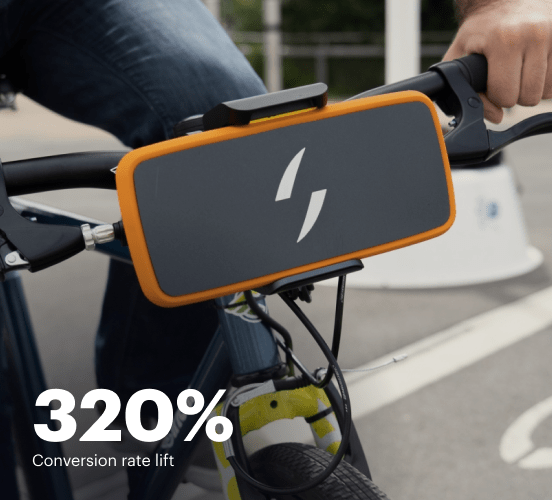How Microsoft Forms vs. Elementor vs. Instapage stack up against each other
Compare Instapage with Microsoft Forms and Elementor to create high-converting landing pages. With personalization, optimization, and collaboration tools, Instapage helps you deliver experiences that drive results.
Get startedSee how Instapage stacks up against the competition
| Feature | Instapage | Other builders |
| Drag-and-Drop Tools | ||
| Conversion-optimized templates | ||
| Manual and AI-powered A/B Tests | ||
| AI content suggestions | ||
| Popups and sticky bars | ||
| Canvas and grid blocks | ||
| Reusable and global elements | ||
| Form and popup builders | ||
| Built-in Heatmaps | ||
| Central analytics dashboard | ||
| Ad-to-page personalization and collections | ||
| Contacts, lists, and email | ||
| Dedicated, full-service CRO experts | ||
| Enterprise-ready platform |
Leading the way in building high-performing landing pages





Why Instapage is the smarter choice for your campaigns
Get everything you need to build, scale, and optimize high-converting landing pages—without coding.

Easier page building without coding
Instapage offers a flexible and seamless page creation experience with a library of 500+ conversion-focused layouts, Instablocks®, a drag-and-drop builder, and AI content generation. With technologies like Thor Render Engine®, you can create on-brand, mobile-responsive landing pages that load quickly and start converting during initial visitor clicks.

More insights — better results
Instapage lets you see in detail how each landing page experience and variation is performing so you can make targeted changes that boost page conversions. Use heatmaps for a better understanding of on-page activities, run A/B tests and AI-assisted experiments, and then track and evaluate results within robust analytics dashboards.

More personalized experiences
Instapage lets you quickly create high-performing landing pages tailored to each of your ad campaigns. Deliver personalized experiences for distinct audiences using dynamic text replacement. Effortlessly align specific advertisements to unique pages with AdMaps. Monitor audience-level metrics using our advanced data tools.

Built-in collaboration
Instapage collaboration capabilities bring your entire team together to speed up the process of landing page review, approval, and launch. No more frustrating and unnecessary revisions or edits scattered across emails. Provide instant feedback, conduct real-time page edits, and securely share your pages with outside stakeholders.

Free up time for your business
Invest time into business growth, not busy work. Launch landing pages faster with reusable forms and templates. Build once, reuse forever.
Explore all integrations






Easier page building without coding
Instapage offers a flexible and seamless page creation experience with a library of 500+ conversion-focused layouts, Instablocks®, a drag-and-drop builder, and AI content generation. With technologies like Thor Render Engine®, you can create on-brand, mobile-responsive landing pages that load quickly and start converting during initial visitor clicks.
More insights — better results
Instapage lets you see in detail how each landing page experience and variation is performing so you can make targeted changes that boost page conversions. Use heatmaps for a better understanding of on-page activities, run A/B tests and AI-assisted experiments, and then track and evaluate results within robust analytics dashboards.
More personalized experiences
Instapage lets you quickly create high-performing landing pages tailored to each of your ad campaigns. Deliver personalized experiences for distinct audiences using dynamic text replacement. Effortlessly align specific advertisements to unique pages with AdMaps. Monitor audience-level metrics using our advanced data tools.
Built-in collaboration
Instapage collaboration capabilities bring your entire team together to speed up the process of landing page review, approval, and launch. No more frustrating and unnecessary revisions or edits scattered across emails. Provide instant feedback, conduct real-time page edits, and securely share your pages with outside stakeholders.
Free up time for your business
Invest time into business growth, not busy work. Launch landing pages faster with reusable forms and templates. Build once, reuse forever.
Explore all integrationsGet started with Instapage in a few steps
-
Create your Instapage account
Start with Instapage by signing up via Google or your email. You'll get access to a free 14-day trial to discover Instapage capabilities. Feel free to cancel anytime during the 14-day trial if you decide that our product is not suitable for your business. -
Build and personalize your page
Create your first landing page from scratch or choose a template from 500+ customizable layouts. Use the drag-and-drop builder to add page elements, fonts, and backgrounds, refine content with AI, or add custom HTML, Javascript, and CSS. -
Review and make edits
Collaborate on page designs and streamline review processes. Invite your team members and stakeholders to review, edit, and provide feedback on your landing page. Collaborate knowing your page is confidential and only accessible to authorized users. -
Publish and track page performance
Publish your page to a domain or custom URL. Connect your pages to the ads you've created and track page performance within the analytics dashboard, run A/B tests and AI experiments, analyze results, and continuously optimize your landing page to maintain high conversions.
Instapage vs. Microsoft Forms vs. Elementor – The Battle for Digital Dominance
Choosing the right landing page builder can feel a bit like assembling your dream team of superheroes for the ultimate quest. You want a reliable fighter, a charismatic leader, and a savvy strategist to conquer the marketing landscape. In this digital arena, we have three contenders stepping into the spotlight: Instapage, Microsoft Forms, and Elementor. Armed with unique strengths, they each offer something special to marketers seeking optimal outcomes. This article promises to deliver a thorough comparison, aimed at empowering you, the marketer, with the insights needed to make an informed choice. As we traverse the features, performance, usability, and costs associated with each contender, we’ll also emphasize how Instapage empowers marketers to reduce costs, grow conversions, and deliver relevant landing page experiences that increase brand trust, customer loyalty, and conversion rates. Let’s embark on this thrilling journey of discovery together!
Meet the Contenders: The Heroes of the Landing Page World
First up, we have Instapage, carving its niche as the go-to platform for marketers looking to craft stunning, high-converting landing pages. With an emphasis on customization and optimization, Instapage stands out for its dedicated tools that streamline the conversion process. Next, we have Microsoft Forms, often lauded for its simplicity and integration within the Microsoft ecosystem. While it may not offer the same level of customization as Instapage, it’s a necessary tool for data collection and survey creation—ideal for users who need straightforward functionalities. Lastly, we have Elementor, a popular WordPress plugin that transforms any existing site into a dynamic platform for building landing pages. For users who wish to blend their existing WordPress capabilities with a robust landing page builder, Elementor presents an appealing solution. Each of these tools brings specific strengths to the table, making them worthy competitors in the digital marketing realm.
Round One: Feature Spotlight - A Closer Look at Capabilities
Templates and Usability - Who Offers More?
In the realm of templates and usability, all three platforms offer distinct advantages. Microsoft Forms presents users with a selection of simple, ready-to-use forms; however, its template choices are relatively limited, focusing more on function rather than flair. This simplicity, while advantageous for quick set-ups, may leave those seeking creative freedom feeling constrained. On the other hand, Elementor provides an extensive library of customizable templates that integrate seamlessly with WordPress, catering to those who want to maintain brand aesthetics while having the freedom to design unique layouts. Each template can be easily modified with a drag-and-drop feature, allowing designers of all levels to create visually appealing pages. Instapage shines in this department by offering an impressive range of conversion-optimized templates designed explicitly for landing pages. Its tools allow users quick access to industry-specific templates tailored for various campaigns, helping marketers engage visitors effectively. Ultimately, while Microsoft Forms is efficient for data collection, it doesn't compete with the creativity and specialization found in Instapage and Elementor.
Instapage: Unmatched Customization Tailored to Success
Instapage sets itself apart through its remarkable customization features. By prioritizing user experience, the platform offers a range of tools that enhance conversion rates seamlessly. Users can easily design customized landing pages with layouts that align with their brand voice and goals. What truly makes Instapage a partner in success is its focus on conversion optimization; with functionalities like A/B testing, heatmaps, and dynamic text replacement, marketers can effectively monitor and adjust campaigns for peak performance. Moreover, Instapage’s unique collaboration tools encourage teamwork, allowing multiple users to contribute to and refine landing page designs in real-time. This collaborative spirit is essential for teams aiming to produce impactful, polished campaigns swiftly, further highlighting why Instapage is favored among marketers.
Round Two: The Race for Speed and Performance
In the speed and performance arena, the user experience plays a crucial role; nobody enjoys waiting for a slow-loading page. Imagine standing in line at your favorite coffee shop only to find that the barista is taking their sweet time—how likely are you to return? Similarly, a slow-loading landing page can deter potential customers from converting. Each platform handles speed differently based on their underlying infrastructure and optimization strategies. Speed is a significant factor that can influence user behavior and ultimately affect conversion rates.
Instapage Advantages:
- Instapage is designed for speed with its optimization tools that ensure quick load times.
- The platform provides advanced caching systems which enhance performance during peak traffic.
- Instapage’s goal-oriented designs lead to higher conversion rates, helping to minimize bounce rates.
- With mobile-responsive templates, Instapage ensures a smooth user experience on all devices.
Microsoft Forms Advantages:
- Simple and effective forms load quickly, making data collection seamless.
- Microsoft’s back-end infrastructure allows for reliable performance even with high user traffic.
- The integration with Office 365 ensures fast access to user data and efficiency in collection.
Elementor Advantages:
- Due to its efficient coding, Elementor pages tend to load quickly when built correctly.
- The drag-and-drop interface is user-friendly and facilitates quicker page creation.
- Regular updates from Elementor help maintain optimal performance and security for users.
In conclusion, speed and performance are pivotal for landing page builders, and Instapage undoubtedly parallels its competitors in these aspects. However, it stands out with its specific focus on conversion rate optimization, ensuring not just speed, but effectiveness in delivering results.
Round Three: Usability & Learning Curve – How Easy Are They to Navigate?
Navigating each platform can reflect the personality of its users. Instapage boasts a smooth onboarding process, allowing even newcomers to feel at ease when entering the world of landing page creation. Tutorials, tooltips, and support articles provide comprehensive guidance for those just starting out while still offering advanced options for seasoned marketers. Microsoft Forms, with its no-frills interface, might seem straightforward for basic needs, but users accustomed to landing page optimization might find it lacking in advanced functionality. Conversely, Elementor invites users into its vibrant ecosystem, ease in modifying existing WordPress sites into stunning landing pages. Despite an initial learning curve with its myriad of options, once learners grasp its capabilities, they usually feel empowered to create impactful designs quickly. Ultimately, all three platforms welcome users, though Instapage offers perhaps the most supportive environment dedicated specifically to effective landing page execution.
Round Four: Support – The Backup Your Business Needs
Customer support serves as the backbone of these platforms, often resembling trustworthy sidekicks ready to assist during critical moments. Instapage offers robust support options, including live chat, ticketing systems, and an extensive knowledge base that empowers users to find solutions independently. It also includes onboarding sessions tailored to get users up to speed quickly. Microsoft Forms typically benefits from the broader Microsoft support ecosystem but can feel a bit impersonal—it's effective but lacks the intimate touch seen in more dedicated service providers. On the other hand, Elementor’s community forums are dynamic and active, providing insights and assistance from other users, which creates a supportive environment that can lead to innovative solutions and shared best practices. Each platform aims to provide necessary support, yet Instapage is particularly notable for its comprehensive approach tailored towards its user demographic.
Round Five: Pricing – Finding Value in Your Investment
Price structures vary significantly among these platforms. Instapage offers several tailored pricing tiers, allowing users to choose based on their specific needs and feature requirements. This flexibility ensures that diverse businesses can find a suitable plan, delivering significant value given the ROI potential through enhanced conversions. Microsoft Forms comes included in many Office 365 subscriptions, making it a cost-effective option for existing Microsoft users; however, it might not provide the same extensive landing page capabilities found elsewhere. Elementor has a freemium model, allowing users to start at no cost, but unlocking its full potential requires a premium subscription. The key takeaway is that while pricing varies, it’s essential for users to assess which features align with their goals when making a choice. It’s not just about the cost; it’s about choosing a platform that drives results.
To wrap up, all three of these platforms possess unique strengths appealing to different user needs. While cost, features, and support must be considered, ultimately, deciding on the right landing page builder hinges on personal preferences and objectives. Marketers should carefully reflect on what they find most valuable in their chosen platform—be it customization, speed, or ease of use. For those who are ready to take the plunge, why not explore what Instapage can do? A free trial or demo can offer critical insights into how it might meet your marketing aspirations.










